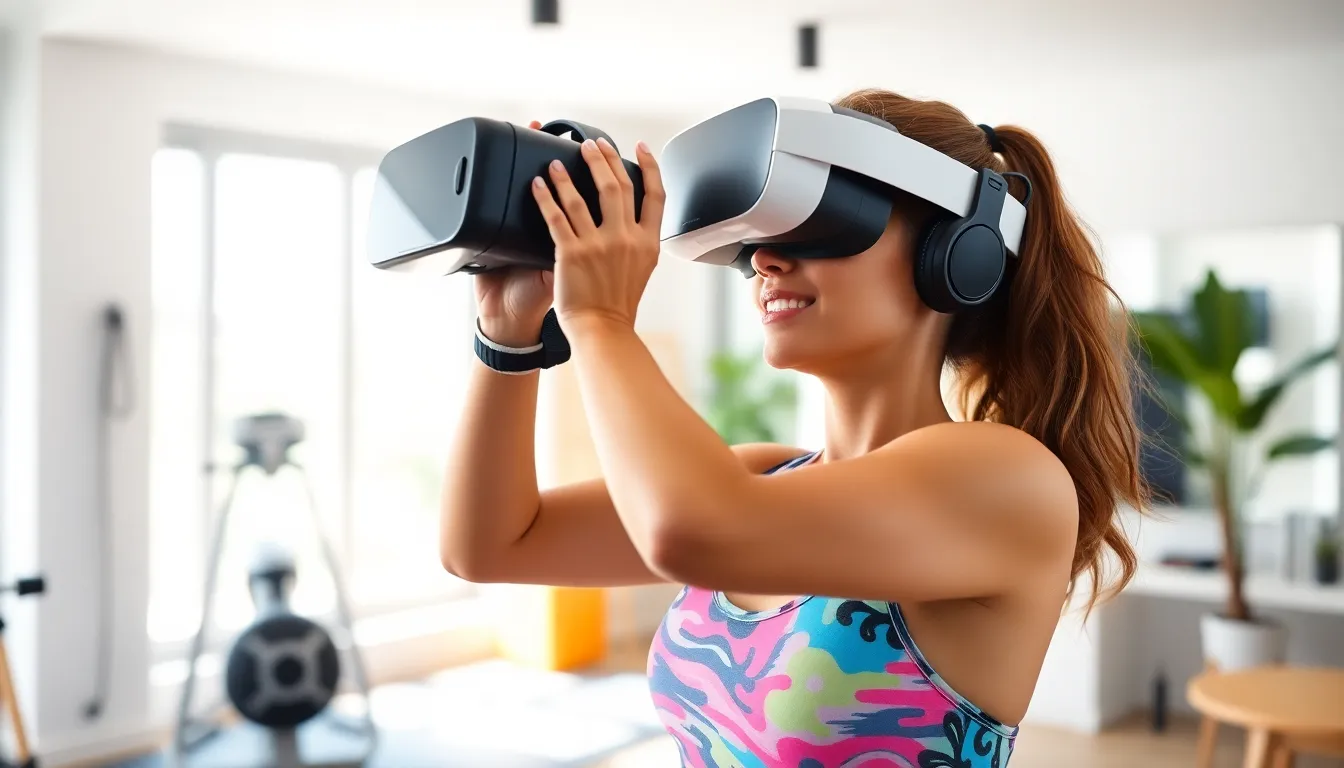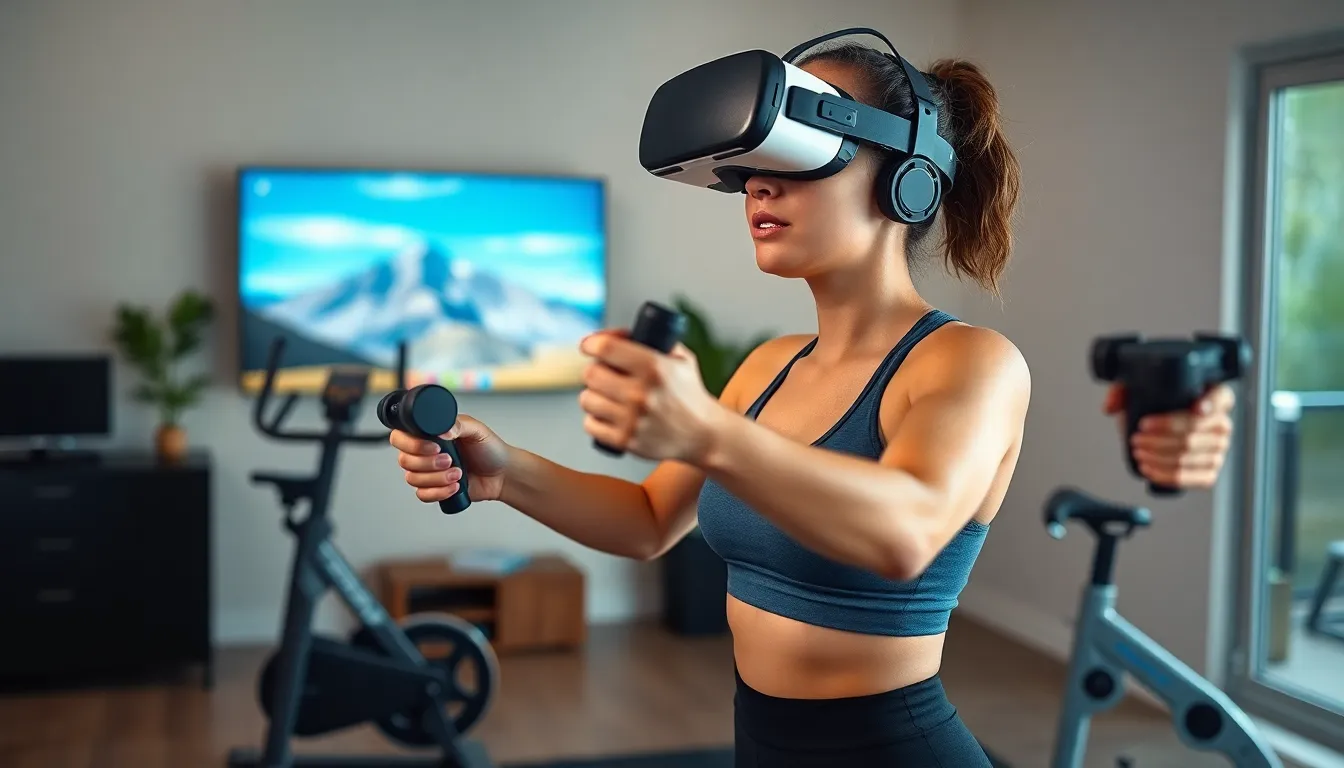Table of Contents
ToggleIn a world where couch potatoes are evolving into tech-savvy fitness buffs, technology-enhanced exercise is taking the fitness scene by storm. Gone are the days of monotonous workouts; now, people can break a sweat while virtually scaling mountains or dancing with avatars in their living rooms. Who knew that sweating could be as fun as binge-watching your favorite series?
Overview of Technology-Enhanced Exercise
Technology-enhanced exercise transforms traditional fitness routines into interactive and engaging experiences. Digital platforms integrate features like gamification and virtual reality to make workouts enjoyable. Wearable devices track performance metrics, providing real-time feedback and encouraging users to reach their fitness goals.
Virtual classes offer convenience, enabling users to participate from home at their own schedules. Personalized training apps utilize algorithms to tailor workout programs to individual needs, enhancing motivation and results. Fitness communities foster social connections, allowing individuals to share achievements and challenge each other.
Innovative equipment like smart bikes and treadmills provides immersive environments, simulating outdoor settings. Motion-tracking software analyzes movement, facilitating improved exercise form and reducing the risk of injury. Enhanced connectivity between devices allows for seamless data synchronization, supporting a comprehensive view of fitness progress.
Users can also access extensive libraries of workout routines, catering to various skill levels and preferences. Interactive challenges and leaderboards promote friendly competition, making fitness more appealing. Mobile apps further facilitate this engagement, offering guided workouts, nutrition advice, and habit tracking.
This integration of technology not only enhances physical fitness but also addresses mental well-being. Mindfulness and meditation apps incorporate breathing exercises and relaxation techniques during workouts. The overall approach encourages a holistic understanding of health, all while keeping users motivated and entertained during their fitness journeys.
Types of Technology-Enhanced Exercise

Technology-enhanced exercise includes various tools and platforms that significantly improve workout experiences. These innovations cater to different fitness preferences and goals.
Wearable Fitness Trackers
Wearable fitness trackers monitor physical activity and provide real-time data on heart rate, steps taken, and calories burned. Users appreciate features like sleep tracking and customizable goals, which enhance their understanding of personal health. Popular devices from brands like Fitbit and Garmin offer apps for analyzing performance metrics, making it easier for individuals to adjust workouts accordingly. These trackers foster accountability and motivation by enabling users to share their progress within fitness communities.
Mobile Fitness Apps
Mobile fitness apps offer customized training programs and access to diverse workout options. Users can choose from strength training, yoga, or cardio classes tailored to varying fitness levels. Many apps incorporate video demonstrations and instructional cues to guide exercises effectively. Notable examples include MyFitnessPal and Strava, which track nutrition and exercise while allowing social engagement. The convenience of accessing workouts anytime and anywhere keeps users actively engaged in their fitness journeys.
Virtual Reality Workouts
Virtual reality workouts provide immersive fitness experiences that simulate different environments. These interactive sessions make activities like cycling or boxing feel engaging and dynamic. Users often find motivation in competing against avatars or friends in virtual settings. Platforms like Oculus and VR Fitness Insider expand options for workouts by enhancing enjoyment and minimizing monotony. Participants experience a new level of excitement and creativity in their routines while benefiting from the advantages of traditional exercises.
Benefits of Technology-Enhanced Exercise
Technology enhances exercise routines by improving user motivation and engagement, along with offering personalized fitness programs.
Improved Motivation and Engagement
Technology significantly boosts motivation by making workouts enjoyable. Gamification elements like rewards and challenges create a playful atmosphere, encouraging participants to push their limits. Interactive platforms keep users connected, making fitness a communal effort. Virtual classes provide an opportunity to train with friends or join larger groups, which fosters accountability. Real-time feedback from wearable devices also drives improvement and keeps users informed about their progress. Users benefit from engaging experiences, such as virtual climbs and dance-offs, transforming traditional workouts into adventures. Each workout can feel like a new journey, increasing retention and commitment to fitness goals.
Personalized Fitness Programs
Personalization in fitness transforms the user experience. Fitness apps analyze individual data to create tailored workout plans that align with specific goals. These programs accommodate varying fitness levels, ensuring that exercises remain challenging yet achievable. Users receive recommendations based on their performance metrics, adjusting workouts to promote continuous improvement. Wearable technology tracks activity, providing insights into user preferences and habits. This data-driven approach fosters accountability and enables users to stay engaged. Accessible libraries of workouts further enhance personalization, allowing users to select routines according to interests, schedules, and available equipment. With customized support, users can progress safely and effectively on their fitness journey.
Challenges and Considerations
Technology-enhanced exercise presents unique challenges that users must navigate. Awareness of these issues leads to a more informed fitness experience.
Privacy and Data Security
Wearable fitness devices collect extensive personal data, including location, heart rate, and activity levels. Users should prioritize understanding how this information is stored and shared. Many companies outline their privacy policies clearly, yet it’s essential for users to read and grasp these terms. Data breaches pose risks, making robust security measures crucial. Engaging with platforms that prioritize encryption and user consent adds a layer of protection. Individuals must remain vigilant in monitoring their accounts for unusual activity. Awareness about data usage and privacy rights empowers users to protect their information effectively.
Dependence on Technology
Overreliance on technology can lead to diminished motivation for traditional workouts. Users may become accustomed to interactive experiences and neglect outdoor or gym exercises. Adjusting to a balance between digital and real-world activities is vital for overall fitness. Users should incorporate screen-free sessions into their routines to cultivate varied habits. Equipment malfunctions and software glitches might disrupt workout plans, causing frustration. Therefore, maintaining a well-rounded fitness routine is essential. Cultivating resilience and adaptability strengthens physical and mental health, even when technology fails. Increasing awareness of potential pitfalls ensures users remain engaged and motivated in their fitness journeys.
Future Trends in Technology-Enhanced Exercise
Innovations continue to shape technology-enhanced exercise, driving new trends. Artificial intelligence plays a key role, creating adaptive workout programs based on user performance data. Personalized feedback becomes more sophisticated, allowing for a tailored fitness experience that adjusts in real-time.
Wearable devices continually evolve, monitoring not only activity but also sleep patterns and recovery metrics. Enhanced accuracy in tracking health data helps individuals make informed decisions about their fitness routines. Fitness apps increasingly integrate social features, promoting community engagement and competition among users.
Virtual reality workouts gain popularity, offering immersive environments that motivate users to stay active. These engaging experiences often simulate outdoor activity, combining exercise with adventure. Interactive fitness platforms embrace gamification more extensively, challenging users with rewards for achieving specific goals.
Home gym equipment incorporates smart technology, connecting with apps to provide guided workouts and track progress. Advanced motion-tracking systems improve exercise form, which aids in reducing injury risk. Integrating augmented reality into workouts allows users to visualize results in real time, further enhancing motivation.
Alongside physical fitness, mental well-being continues to receive attention through technology. Wellness apps focusing on mindfulness and meditation supplement traditional workouts, promoting a holistic view of health. Maintaining mental resilience becomes vital as technology shapes the fitness landscape.
The emergence of hybrid models combines online and in-person training, giving users flexibility. Individuals can attend live classes or access pre-recorded sessions based on personal schedules. Fitness instructors harness technology to reach broader audiences, expanding their impact and community-building efforts.
Trends point toward the continual convergence of technology and wellness, making fitness more accessible, engaging, and personalized. By staying informed about these developments, individuals can effectively enhance their fitness journeys.
Technology-enhanced exercise is revolutionizing the way individuals approach fitness. By transforming mundane routines into engaging experiences, it fosters a sense of enjoyment and motivation. The integration of gamification, virtual reality, and personalized training apps caters to diverse fitness preferences and goals.
As users navigate this tech-driven landscape, it’s crucial to remain aware of privacy concerns and the potential pitfalls of overreliance on digital solutions. A balanced approach that incorporates both technology and traditional workouts can lead to sustainable fitness habits.
With continuous advancements in wearable devices and fitness apps, the future of exercise promises even greater personalization and community engagement. Embracing these innovations while maintaining a holistic view of health ensures an enriching fitness journey for everyone.





